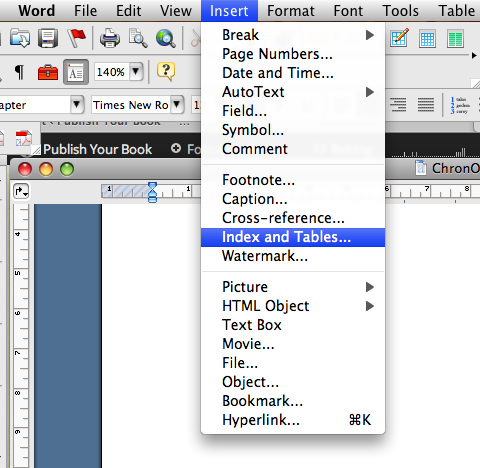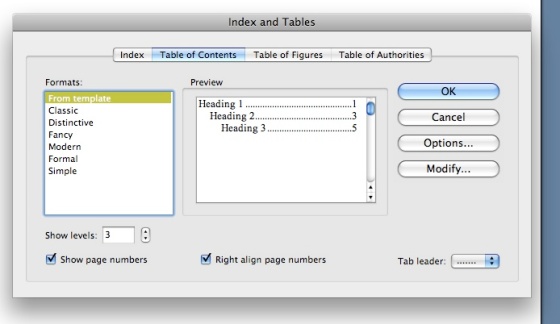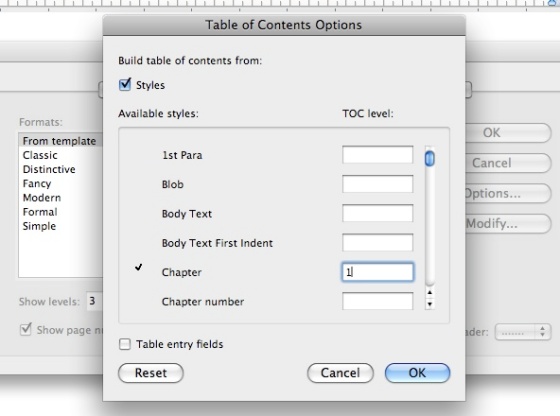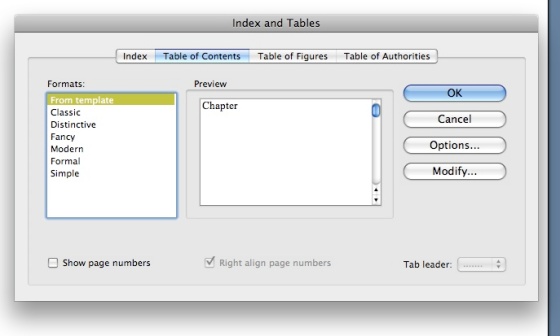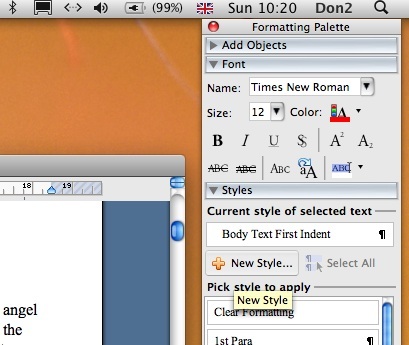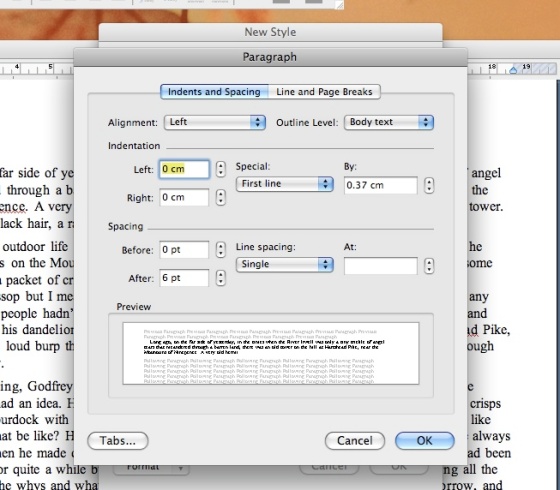
Preparing your book for publishing on Kindle is very different to preparing a book for printing. When preparing a book for print publishing you have control of fonts, type size and spacing etc. On the Kindle you can’t control any of those things because the reader controls the appearance of the book on their Kindle. So your job as the author / publisher is to make their Kindle experience of your book the best it can be.
We want to create a text file that will flow on the Kindle the way the reader wants it to. I am assuming you have a copy of your text in MS Word. I’m no fan of Word but if you are going to publish on the Kindle you should get a copy because that is the accepted text file standard.
Go to SAVE AS and save a copy of your work as MyBookKindle01.doc (where ‘MyBook’ is the title of your book). This is so if you mess up you can go back to your original file and start again. Then we start work on the formatting.
1. KILL THE TABS
The first job is to strip out any formatting you have put into your text. If you have used the dreaded TAB key in your text, you need to find every TAB and delete it. TAB will not line up on the Kindle as it does on your screen. It will make your text display like a dogs dinner. Delete all TAB spaces. (If you used TAB to set a quote in an indented block – still delete the TABS. Later on you can go back to your quotes and use INDENT which will work on a Kindle.)
2. KILL THE FONTS
Next go to EDIT and SELECT ALL. Go to FORMAT … FONT and change the whole text to TIMES or TIMES NEW ROMAN and select 12pt text. Click OK.

Select All and change to 12pt Times
You can go back later and put back things you had in italics, but for now we want everything in 12pt Times.
3. KILL THE EMPTY LINES
If you put a blank line between every paragraph, I’ve got some bad news for you. You need to go through and delete every empty line. The one exception is if you left a blank line to indicate a change of scene:
John tossed and turned as he tried to get to sleep that night.
[blank line]
Clicking the kettle on was an automatic action as John stumbled into the kitchen for breakfast…
But all the other blank lines MUST be deleted. In my book The Chronicles of Godfrey the scene keeps changing from Heaven to Earth in some chapters. But instead of leaving blank lines I used what I call a scene change blob, which I make with three ‘o’s, the middle one in caps.
oOo
And I centre the blob.
If you have any places where you have left a big gap made with a series of blank lines, they too must be deleted because on a Kindle, that may cause a series of blank pages on the device, and Kindle books should have no blank pages, unlike print versions.
Even when you come to a new chapter it needs to just start on the next line. In the next step, we will deal with chapters appearing on a new page.
4. CREATE CHAPTER BREAKS
You can’t create chapters starting on a new page by using blank lines on a Kindle. You must use the PAGE BREAK function in Word. Those few pages at the beginning of a book – title/ copyright / dedication etc should be included in your Kindle version. But there should be no blank pages.
After your title page:
MY GREAT BOOK
by
A. COOLWRITER
Put the cursor just before the first letter of your copyright notice, which could look something like this:
Copyright © Don Egan 2013
The right of Don Egan to be identified as author of this work has been asserted by him in accordance with the Copyright, Designs and Patents Act 1988.
All rights reserved.
Kindle Edition
Now we are going to make that start on a new page by inserting a page break. Go to INSERT / BREAK / PAGE BREAK.

Your copyright page will now jump to the next page. Go to the beginning of every chapter and insert your cursor in front of the first word of your chapter title. This will make every chapter of your book start at the top of a fresh page on the Kindle.
5. CREATE PARAGRAPH INDENTS WITH A BODY TEXT STYLE
Kindle files should have an indent on the first line of each paragraph. It can also make reading easier if we arrange a small space after each paragraph. Leaving a blank line between each paragraph is too much space but typeset text usually has a little gap between each paragraph. We can do this by creating a STYLE and calling it BODY TEXT or something similar.
We do this by creating a STYLE in the FORMATTING PALETTE. Go to STYLES and click the triangle to open the styles section.
There will be a few styles already in the palette but click the NEW STYLE button so you can create your own.
This opens the NEW STYLE window. First give the new style a name like BODY TEXT. Under FORMATTING select TIMES and 12pt. Just underneath select LEFT JUSTIFIED TEXT symbol and NORMAL SPACING symbol as shown.
Then click on the pop up menu at the bottom of the window which reads FORMAT. Then select PARAGRAPH…
This opens the PARAGRAPH window. In INDENTATION set SPECIAL to FIRST LINE and then BY to about 0.5. This will indent the first line of each paragraph by 0.5 cm.
Then under SPACING set AFTER to 6pt. This will create a small space between each paragraph. Then click OK.
Now back in the text of your book go to EDIT and the SELECT ALL. Then in the FORMATTING PALETTE under STYLES click on the style you just created BODY TEXT or whatever you called it.
This should format your whole text. Click into the text to deselect everything.
Now we need to go back the the FORMATTING PALETTE and STYLES and create a NEW STYLE called CHAPTER. This will be the same as BODY TEXT but in BOLD and with no indent, and CENTRED. As below.
Now go through your text and change all your Chapter Headings to the CHAPTER STYLE.
That’s most of the work done.
Click SAVE AS and save a copy of your work as MyBookKindle02.doc
Now you just need to create a TABLE OF CONTENTS and INSERT a few BOOKMARKS and you are good to go. I will explain these two steps in the
next post.







